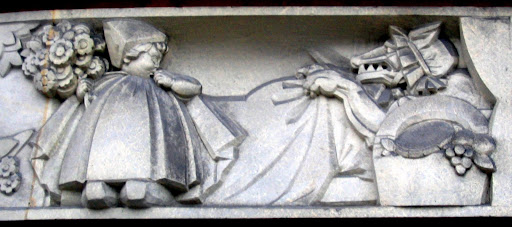



Drumpark is a school for children with various kinds of learning needs, from nursery to senior ages. It is on the western edge of Coatbridge, at Bargeddie (now North Lanarkshire). It was designed by JR Stewart in 1925, has a butterfly-plan and must rank as one of Scotland's earliest open-air schools. It is both rational and picturesque, being adorned with pyramidal hexagonal entrance towers (with clerestory lighting) to both north and south, having south-facing verandas and classrooms with glazed sliding doors, and being one-storey. It was decorated by Jessie King and her husband E.A. Taylor. Renowned for their contribution to the so-called Glasgow Style in the early twentieth century, Drumpark continued a trend of designing for children that King had already been engaged upon for two decades (e.g. toys, illustrations, models). On 6 September 1927, The Glasgow Herald noted:
The outstanding feature of the school is the scheme of decoration adopted for the various classrooms.... A different design and combination of colour harmonies have been chosen for each classroom, and while there is fascinating variety, there is also a pleasing unity in the entire scheme.
It was a happy inspiration on the part of the artists to choose wild flowers in each case as the basis of the scheme. In one room, for example, the motif is that of forget-me-nots. The colour most in evidence is, of course, the pale blue of this favourite flower, while the wall decoration consists of forget-me-not flowers, among which there flit elusive elf-like figures. 'Wild Rose' is another motif which, in soft shades of pink, lends itself admirably to imaginative treatment of this description. There is a 'Primrose' classroom in pale yellow, and a 'Daffodil' and a 'Crocus' room in varying shades of the same colour, while 'Snowdrop', 'Old Rose', 'Gorse' and other flowers all receive appropriate treatment. Not only are the decorations of the various rooms soundly and simply conceived and executed as designs, but, more important still, they are calculated to appeal strongly to the imagination of children...'
Colin White, in The Enchanted World of Jessie M. King (1989), has noted the following:
'in the autumn of 1925 he [E.A. Taylor – husband of Jessie King] and Jessie had been invited to design the interior decorations for a new experimental nursery school that the Lanarkshire authorities were building at Drumpark for handicapped children. The Taylors were given a free hand, and decided to base their designs on flowers. Ernest chose the colour schemes and Jessie prepared stencilled friezes for the walls, with elves and fairies playing among clusters of 'Primrose', 'Snowdrop', 'Old Rose' and the other flowers that were used as names for the classrooms. In 'Sunflower', for example, elfin soldiers, in armour made of sunflower petals, fought one another by the light of a rising sunflower sun. Jessie paid several visits to the school to get the feel of the siting of the murals and their scale. She made large preliminary sketches of her compositions in charcoal and colour washes and, from these, made detailed paintings in gouache. The actual cutting of the stencils was done under her supervision by the firm of decorators who were painting the school, and she and Ernest attended to the mixing of the colours they had decided on… It was the first time that children's taste had been given consideration in the planning of a new school. The success of the venture encouraged the Lanarkshire authorities to repeat the experiment the following year at Machen [now Machanhill?], a new school at Larkhall, and the Taylors were invited again to plan the décor for the seven classrooms for the youngest children… Jessie painted one of her few oils, Little Brown Seed, for Drumpark School….'
While the classroom decorative scheme has vanished, the 'Little Brown Seed' mural survives. Its text is from Edith Nesbit (of Railway Children and Fabian Society fame) - in fact it is her poem called Baby Seed Song. This is both written (in Glasgow Style capitals with dots between words) and illustrated (by anthropomorphic poppy and sunflower seeds in a slightly oriental stylised birch grove). The poem and mural are still used as reading and learning resources today.
In 2009 the school installed, at the end of a corridor, a ceramic mural made of ten hexagons by the children (under the supervision of ceramicists Fiona Fleming and Julia Smith) and depicting various facets of Drumpark life, past and present. It makes a fitting accompaniment to Jessie King's work.
Drumpark is about to close and the future of the building is uncertain. Andrew D and I are very grateful to Mrs Millar, Miss King, Mr Doherty and the Headteacher for sharing with us their tremendous appreciation of the school.
Drumpark is about to close and the future of the building is uncertain. Andrew D and I are very grateful to Mrs Millar, Miss King, Mr Doherty and the Headteacher for sharing with us their tremendous appreciation of the school.

No comments:
Post a Comment